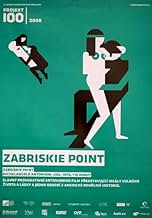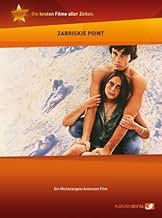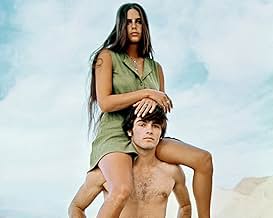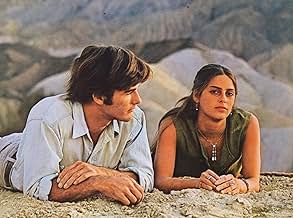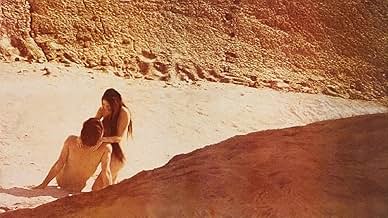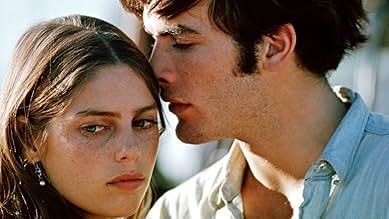AVALIAÇÃO DA IMDb
6,9/10
18 mil
SUA AVALIAÇÃO
Numa época de agitação civil crónica no final dos anos 60, a América.Numa época de agitação civil crónica no final dos anos 60, a América.Numa época de agitação civil crónica no final dos anos 60, a América.
- Direção
- Roteiristas
- Artistas
- Prêmios
- 1 vitória e 1 indicação no total
Martin Abrahams
- Radical student
- (não creditado)
Michael L. Davis
- Police lieutenant on loudspeaker
- (não creditado)
Lee Duncan
- Highway patrolman
- (não creditado)
George Dunn
- Airport mechanic
- (não creditado)
Dennis Falt
- University student
- (não creditado)
Harrison Ford
- Arrested student
- (não creditado)
Jim Goldrup
- College student
- (não creditado)
Norman Grabowski
- Man in Deli
- (não creditado)
Bill Hickman
- Gun store owner
- (não creditado)
- …
Kenner G. Kemp
- Departing Plane Passenger
- (não creditado)
Peter Lake
- Documentary cameraman
- (não creditado)
Avaliações em destaque
Antonioni really showed some 'cojones' when he had this movie made. He went to America working under a contract from the most lavish studio (MGM) and he made the most damning portrait of American society i've ever seen. Having seen LA first hand this is the most accurate portrayal of the crowded, overheated and impersonal city. If only Antonioni had met Bill Hicks...
The subsequent burial by the studio is understandable, after such a whopping investment and dismal return. It is sad that people don't get to see this film any more as i believe Antonioni has been proved right. Here he predicts the end of the hippie/civil rights movement in the politics of America. Everyone is much more interested in what goes into their pockets and the relentless expansion of living space into the inhospitable (yet beautiful) desert and beyond. How i would love to see interest in this film re-kindled and a lavish DVD release.
I beseech people to watch Zabriskie Point with an open mind and an open heart. We have a genuinely unique film commenting on a turning point in the history of the most powerful nation on the planet, and we have forgotten about it.
An unexpected gem.
The subsequent burial by the studio is understandable, after such a whopping investment and dismal return. It is sad that people don't get to see this film any more as i believe Antonioni has been proved right. Here he predicts the end of the hippie/civil rights movement in the politics of America. Everyone is much more interested in what goes into their pockets and the relentless expansion of living space into the inhospitable (yet beautiful) desert and beyond. How i would love to see interest in this film re-kindled and a lavish DVD release.
I beseech people to watch Zabriskie Point with an open mind and an open heart. We have a genuinely unique film commenting on a turning point in the history of the most powerful nation on the planet, and we have forgotten about it.
An unexpected gem.
At the time of its release, ZABRISKE POINT caused great division in film-going circles. A "wannabe classic but artless piece of empty canvas" was the view of the establishment, most critics included. To the alternative movement...a "revelation of everything that is wrong in the world today (1970)" Not too much has changed judging by the comments here, although an overall user-rating of an almost respectable 6.2 suggests an increase in the appreciation factor.
Poor old Mark Frechette and Daria Halpin as the star crossed lovers - definitely in the wrong place at the wrong time (weren't they EVERY wronged and downtrodden teenager of the period???) copped most of the flack, totally unreasonably. They were SUPPOSED to be Mr and Miss typical troubled youth, not Rhett Butler and Scarlett O'Hara on a bender! This was an image-driven film and many flag waving americans were incensed that Italy's outre director Antonioni was given free rein to portray the angst of American youth.
Cinematically, the film was awesome. In London at the time, I saw it on its release and thought that from an objective viewpoint it was quite brilliant (admittedly, I was only 24 myself). Many have commented on its alleged self-indulgence. Yeah, well it WAS Antonioni's film - surely he was free to express his art-form in whatever way he saw fit at the time? The desert scenes have not been topped by any film since.
ZABRISKIE POINT may be shy of "masterpiece" status (mind you, who amongst is solely qualified to make THAT call?) but it is probably now, THE defining film of 70's culture. A time when acid trips, communal living, even just plain old fashioned "love" were not that easy a choice to live with!
Poor old Mark Frechette and Daria Halpin as the star crossed lovers - definitely in the wrong place at the wrong time (weren't they EVERY wronged and downtrodden teenager of the period???) copped most of the flack, totally unreasonably. They were SUPPOSED to be Mr and Miss typical troubled youth, not Rhett Butler and Scarlett O'Hara on a bender! This was an image-driven film and many flag waving americans were incensed that Italy's outre director Antonioni was given free rein to portray the angst of American youth.
Cinematically, the film was awesome. In London at the time, I saw it on its release and thought that from an objective viewpoint it was quite brilliant (admittedly, I was only 24 myself). Many have commented on its alleged self-indulgence. Yeah, well it WAS Antonioni's film - surely he was free to express his art-form in whatever way he saw fit at the time? The desert scenes have not been topped by any film since.
ZABRISKIE POINT may be shy of "masterpiece" status (mind you, who amongst is solely qualified to make THAT call?) but it is probably now, THE defining film of 70's culture. A time when acid trips, communal living, even just plain old fashioned "love" were not that easy a choice to live with!
The movie presents a view of the United States that only a foreigner could have. Sadly, foreigners can't relate to it and persons from the United States cannot believe it. The movie is, therefore, caught in limbo without an audience. Reviews of the film tend to reflect this.
I have lived away from the US for 30 years and can now pretend to be able to understand what Antonioni was wanting to achieve. My view is that he has excelled. The film is a stunning indictment of the United States and, tragically, I see no remediation in the 29 years since it was first released.
I have lived away from the US for 30 years and can now pretend to be able to understand what Antonioni was wanting to achieve. My view is that he has excelled. The film is a stunning indictment of the United States and, tragically, I see no remediation in the 29 years since it was first released.
These are the late 60's and the early 70's as I have always imagined. As usual Antonioni uses all the registers of communications: the sounds, the colours, the movements of the actors. You could say that the plot is not well balanced, that the dialogues are often silly and meaningless, and maybe you are right. But Antonioni is a master in evoking feelings, simple, rough feelings, using all the tools a filmmaker has.
The movie has some jewels, and among them the most shining are the 10 final minutes. The oneiric explosion sequence, with the music that comes and goes, with the time expanded and slowed down, with the kitsch colours of meaningless objects moving upward in the blue sky. In the movie history this is one of the best images of the explosive and destructive power of the ingenuity of that generation, that wanted to live changing the existing rules. Playing with colour, time, sounds and music Antonioni has given once more a proof of his unforgettable art: he is at the same time a painter, a music composer, a dancer, a poet.
The movie has some jewels, and among them the most shining are the 10 final minutes. The oneiric explosion sequence, with the music that comes and goes, with the time expanded and slowed down, with the kitsch colours of meaningless objects moving upward in the blue sky. In the movie history this is one of the best images of the explosive and destructive power of the ingenuity of that generation, that wanted to live changing the existing rules. Playing with colour, time, sounds and music Antonioni has given once more a proof of his unforgettable art: he is at the same time a painter, a music composer, a dancer, a poet.
About two hundred members of a Cleveland, Ohio USA film society, named Cinematheque, gathered on August 19, 2000 to view a pristine Cinemascope print of Michelangelo Antonioni's 1970 film, "Zabriskie Point." Cinematheque Director John Ewing, who does a superlative job of obtaining the finest prints for his series, shared with the audience beforehand that this print was specially flown over from Italy for this one showing only.
The audience was held spellbound as the film unfolded its artisty on the huge panoramic screen. Watching this superb print, shown the way Antonioni intended, made one aware that this is indeed a modern art work. It was all the more fitting that the series is housed in the Cleveland Insititue of Art in University Circle.
Antonioni's compositions are created for the Cinemascope landscape. His beautiful balancing of images, striking use of colors, sweeping choreographic movements, all are the work of a genuine artist, using the screen as his canvas.
At last the audience could understand "Zabriskie Point." As its narrative unfolded, it became obvious that this work is not about story per se, but rather an artist's impressionistic rendering of fleeting images of his subject. The setting of some of the more turbulent activities of the sixties provides only a dramatic motor for the artist's sweeping collage.
Antonioni is not bound by conventional narrative standards, and can pause at any point to creatively embroider an event with grandiose embellishments. The audience willingly went with the flow of his remarkable imagination, as his huge images on the massive canvas held one in rapt attention. While the audience may have been only tangentially involved in character relationships, it realized the theme here is human aleination, the director's recurring theme.
It was also realized that no print any smaller or of lesser quality than this original one in Cinemascope can do justice to this particular rendering. The audience was therefore all the more appreciative of viewing "Zabriskie Point" in its original, breathtaking format, and broke into thunderous applause at the end.
The audience was held spellbound as the film unfolded its artisty on the huge panoramic screen. Watching this superb print, shown the way Antonioni intended, made one aware that this is indeed a modern art work. It was all the more fitting that the series is housed in the Cleveland Insititue of Art in University Circle.
Antonioni's compositions are created for the Cinemascope landscape. His beautiful balancing of images, striking use of colors, sweeping choreographic movements, all are the work of a genuine artist, using the screen as his canvas.
At last the audience could understand "Zabriskie Point." As its narrative unfolded, it became obvious that this work is not about story per se, but rather an artist's impressionistic rendering of fleeting images of his subject. The setting of some of the more turbulent activities of the sixties provides only a dramatic motor for the artist's sweeping collage.
Antonioni is not bound by conventional narrative standards, and can pause at any point to creatively embroider an event with grandiose embellishments. The audience willingly went with the flow of his remarkable imagination, as his huge images on the massive canvas held one in rapt attention. While the audience may have been only tangentially involved in character relationships, it realized the theme here is human aleination, the director's recurring theme.
It was also realized that no print any smaller or of lesser quality than this original one in Cinemascope can do justice to this particular rendering. The audience was therefore all the more appreciative of viewing "Zabriskie Point" in its original, breathtaking format, and broke into thunderous applause at the end.
Você sabia?
- CuriosidadesAntonioni met with Jim Morrison during early production to ask for a musical contribution to the soundtrack. Morrison and the Doors provided "L'America" which Antonioni then rejected.
- Erros de gravaçãoZabriskie Point, in Death Valley National Park (California, USA) is not actually the lowest-elevation point in the United States. That would be Badwater Basin, at a depth of 282 feet below sea level, which is also located in Death Valley National Park about 20 miles away.
- Citações
[booking a protester]
Cop: Occupation?
William S. Polit, protester: Associate professor of history.
Cop: That's too long, Bill. I'll just put down clerk.
- Versões alternativasIn the original version, the song that's playing when Daria drives away at the very end and over the closing "End" title card is a Roy Orbison song, but in the 1984 MGM/UA Home Video version it's a continuation of the Pink Floyd song. The 1991 MGM/UA Home Video version restores the Orbison song.
- ConexõesEdited into Histoire(s) du cinéma: La monnaie de l'absolu (1999)
Principais escolhas
Faça login para avaliar e ver a lista de recomendações personalizadas
- How long is Zabriskie Point?Fornecido pela Alexa
Detalhes
Bilheteria
- Orçamento
- US$ 7.000.000 (estimativa)
- Faturamento bruto mundial
- US$ 84.879
- Tempo de duração
- 1 h 53 min(113 min)
- Mixagem de som
- Proporção
- 2.35 : 1
Contribua para esta página
Sugerir uma alteração ou adicionar conteúdo ausente


